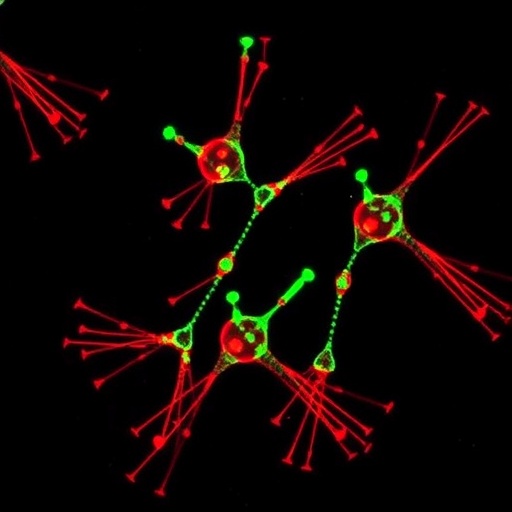In a groundbreaking study that reshapes our understanding of cellular metabolism during proliferation, researchers have uncovered a critical and transient regulatory mechanism involving the Anaphase-Promoting Complex/Cyclosome (APC/C) and its co-activator CDH1, which intricately links cell cycle progression with metabolic reprogramming. This pivotal discovery reveals how ephemeral APC/C inactivation, modulated by mTOR-mediated phosphorylation of CDH1, orchestrates a vital metabolic shift to glycolysis, enabling cells to efficiently coordinate energy production and biosynthetic activity necessary for cell cycle entry.
Cell proliferation demands a harmonized interplay between energy generation and macromolecular synthesis processes, yet the precise molecular controls that synchronize these complex cellular events have remained elusive. The latest research delves deeply into the transient inactivation of the APC/C, an essential ubiquitin ligase complex known for its role in protein degradation during mitosis, demonstrating its unexpected regulatory function at the cusp of cell cycle re-initiation from quiescence. This discovery provides compelling evidence that APC/C inactivation is not merely a consequence of cell cycle progression, but a proactive switch to reshape the cell’s metabolic framework.
Through innovative experimental approaches utilizing MCF-10A human mammary epithelial cells, the research team specifically manipulated the phosphorylation status of CDH1 at threonine 129, creating mutants that either mimic persistent phosphorylation (T129D) or prevent phosphorylation (T129A). The expression of the CDH1(T129A) mutant, which enforces continuous APC/C activation, was found to profoundly inhibit CDK2 activation, a key driver of cell cycle progression, effectively reducing the number of cells entering the cell cycle. Conversely, the CDH1(T129D) mutant, unable to efficiently bind and activate APC/C, showed minimal impact on cell cycle entry, underscoring the necessity of transient APC/C inactivation for proper proliferation.
Central to the study’s findings is the transient accumulation of PFKFB3, a critical glycolytic activator, whose protein stability hinges on APC/C activity. The researchers revealed that transient APC/C inactivation allows for a sharp and timely burst in PFKFB3 levels, elevating glycolytic flux to meet the heightened biosynthetic and energetic demands during early cell cycle re-entry. Pharmacological inhibition of PFKFB3 using PFK15 mirrored the effects of persistent APC/C activation, further validating the dependency of cell cycle entry on glycolytic reprogramming facilitated by APC/C modulation.
Notably, the team employed sophisticated single-cell CDK2 activity biosensors coupled with time-resolved manipulations of CDH1 phosphorylation status and glycolytic enzyme activity to delineate the temporal windows in which these molecular events are critical. They found that even transient perturbations limited to the initial 6-8 hours following mitogen stimulation were sufficient to significantly impair cell cycle progression, highlighting the exquisitely timed nature of APC/C inactivation and glycolytic enhancement during the early G1 phase.
This finely tuned regulatory circuit appears to be driven upstream by mTOR signaling, a master metabolic regulator often implicated in growth control and nutrient sensing. mTOR-mediated phosphorylation of CDH1 transiently suppresses APC/C activity, temporarily lifting suppression on PFKFB3 and possibly other metabolic enzymes. Subsequently, protein phosphatases act to reactivate APC/C by dephosphorylating CDH1, restoring its function and thus creating a dynamic “on-off” switch that balances protein degradation with metabolic demands.
The implications of this discovery extend far beyond basic cell biology, offering novel insights into how disruptions in metabolic regulation can impact diseases characterized by uncontrolled proliferation, including cancer. Given that the Warburg effect — a phenomenon where cancer cells exhibit elevated glycolysis even in oxygen-rich conditions — mirrors the metabolic switch observed here, understanding APC/C’s role may open new avenues for targeted therapies that exploit this transient vulnerability during cell cycle re-entry.
Moreover, this research prompts a reevaluation of APC/C’s traditional perception solely as a mitotic regulator, positioning it as a critical integrator of metabolism and cell cycle machinery. This dual functionality ensures that energy production and biosynthesis are precisely aligned with proliferative signals, thereby safeguarding cellular homeostasis during the demanding process of cell cycle transition from quiescence.
The methodology employed in this study leverages precise genetic and pharmacological tools combined with live-cell imaging, enabling a dissection of temporal dynamics that were previously inaccessible through bulk population analyses. Such single-cell resolution elucidates heterogeneity in cell cycle entry decisions, shedding light on how individual cells interpret and respond to mitogenic cues within their metabolic context.
Furthermore, this work emphasizes the importance of post-translational modifications in regulating complex cellular networks. The phosphorylation-dephosphorylation cycles of CDH1 act as molecular toggles, governing APC/C activity and thus dynamically modulating substrate stability in response to fluctuating intra- and extracellular signals. Such mechanisms underscore the plasticity and adaptability of cell regulatory systems.
By connecting mTOR signaling with APC/C and glycolytic control, the study also integrates two previously disparate fields — nutrient sensing/metabolic regulation and cell cycle control — into a coherent framework that explains how proliferative cues translate into metabolic remodeling necessary for successful cell division.
In conclusion, the discovery that transient APC/C inactivation induced by mTOR-dependent phosphorylation of CDH1 orchestrates a metabolic switch to glycolysis provides a conceptual advance in cell biology. This coordination ensures that energy and biosynthetic needs are met precisely at the moment cells commit to division. These findings not only deepen our understanding of cellular proliferation but also lay the groundwork for innovative therapeutic strategies targeting metabolic vulnerabilities linked to cell cycle dysregulation.
Subject of Research: The coordination of cell cycle entry and metabolic reprogramming via transient APC/C inactivation mediated by mTOR-dependent phosphorylation of CDH1, focusing on glycolytic regulation and its impact on proliferation.
Article Title: Transient APC/C inactivation by mTOR boosts glycolysis during cell cycle entry.
Article References:
Paul, D., Bolhuis, D.L., Yan, H. et al. Transient APC/C inactivation by mTOR boosts glycolysis during cell cycle entry. Nature (2025). https://doi.org/10.1038/s41586-025-09328-w
Image Credits: AI Generated




